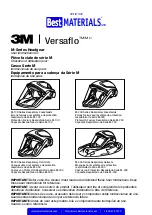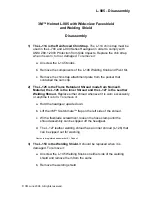
Connections
900-00270-01-001 REV A
©2020 OutBack Power. All Rights Reserved.
Three-Stage Charging
EnergyCell TT batteries are usually charged using a “three-stage” charging cycle: bulk stage, absorption stage, and float
stage. However, not all chargers are designed or programmed the same way. The settings should be checked and changed
to match the recommendations below if necessary.
Bulk Stage
The bulk stage is a constant-current stage. The charge current is
maintained at a constant high level. The battery voltage will rise
as long as the current flows, raising the battery to a high voltage
(usually called bulk or absorption voltage). This typically restores
the battery to 85 to 90% state of charge (SoC). This battery has a
recommended maximum current limit which should not be exceeded.
See the
Specifications
table.
Absorption Stage
The absorption stage is a constant-voltage stage, established upon reaching the bulk target voltage. The charger maintains
this voltage as the current decreases until the batteries are full. A large current is required to reach absorption level. Less is
required to maintain it there. This requirement tends to decrease as long as absorption is maintained. This decreasing
current flow typically goes to a very low number (though not zero), known as “return amps”. This “tops off the tank”, leaving
the battery at 100% SoC. The battery is considered to be completely full upon the following conditions: The charge rate
must decrease to a level of current equal to between 1% and 3% of the total battery amp-hours
while maintaining the
absorption voltage
. At this point the charger is allowed to exit the absorption stage and enter the next stage.
NOTE
: Not all chargers use return amps. Many chargers absorb for a timed period (one or two hours), assuming that the
current will decrease to that level. However, if it exits absorption and ends the charge before reaching return amps, the
battery may not reach 100% SoC. Repeated failure to complete the charge will cause decreased battery life.
Float Stage
The float stage is a maintenance stage which provides current to counter the battery’s natural self-discharge. As with
absorption, float is a constant-voltage stage which supplies only enough current to maintain the designated voltage.
Constant-Float Charging
“Constant-float” charging may be used in backup power applications
where the battery is rarely discharged. When a discharge occurs, it is
critical to recharge the battery as soon as possible afterward. The
voltage range is listed under
Specifications
. The batteries are
considered fully charged when the voltage is maintained at this level
and the current drops to a low level over a long period of time. If using
a battery monitor device such as an OutBack FLEXnet DC, use the
settings shown to the right.
In constant-float charging, it is critical to compensate the charger
settings for temperature.
Temperature Compensation
Battery performance changes when the temperature varies above or below room temperature (77°F or 25°C). When a
battery is cooler than room temperature, its internal resistance goes up and the battery will be undercharged. When warmer
than room temperature, its internal resistance goes down and the battery will tend to be overcharged.
To compensate, a charger must have its voltages raised by a specified amount for every degree below room temperature,
or lowered for every degree above room temperature. For the EnergyCell TT, the required compensation coefficient is
–0.0033 volts per cell per degree C (–0.0018 V/cell/°F). This is also multiplied by the number of batteries in a string.
Charging
Series Strings
Batteries wired in series (negative to positive) have additive voltages.
This is known as a “string”. In the example below, a string of four
EnergyCell TT batteries would have a nominal voltage of 48 Vdc.
However, batteries in series do not have additive amp-hours.
Series / Parallel Strings
Batteries wired in parallel (positive to positive, negative to negative)
have additive amp-hour capacity. Placing several strings in parallel
(series / parallel) gives additive voltages
and
capacity. In the
example below, the system uses four batteries, but not all are in
series. This system uses pairs of batteries in series for 24 volts.
Two pairs are shown in parallel for double the amp-hours.
NOTE:
Consult a professional installer before connecting more than
three strings in parallel.
Hardware
EnergyCell TT terminals consist of a
threaded hole which receives an
M6 × 12 mm bolt. Terminal hardware
is assembled as shown in this image.
Bulk
Bulk
Absorption
Absorption
Float
Float
DC
Volts
Amperes
(typical)
Hours (typical)
Hours (typical)
15
14
13
12
11
10
20
15
10
5
0
–5
1
2
3
1
2
3
Charging Graphs
Charging Voltages
(multiplied by the
number of batteries in a series string)
o
Absorb Charging Voltage
: 14.4 to 15.0 Vdc
o
Equalize Charging Voltage
: 15.0 Vdc
(16 hours every 2 months or 25 cycles)
o
Float Voltage
: 13.5 to 13.8 Vdc
Settings
o
Battery Amp-Hours
: Based on the rated
20-hour capacity (see
Specifications
)
o
Charged Voltage
: 14.0 Vdc
(0.4 volts below absorption setting)
o
Charged Return Amps
: 1 to 3% Adc
o
Time
: 1 minute
o
Charge Factor
: 97%
M6 Bolt
Lock Washer
Flat Washer
Cable Lug or
Interconnect
Battery Terminal
Surface
Positive (+)
Negative (–)
Positive (+)
Negative (–)






















